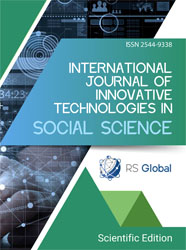HYPERTROPHIC CARDIOMYOPATHY IN ATHLETES - A LITERATURE REVIEW
Abstract
Background: Hypertrophic cardiomyopathy (HCM) is one of the most common hereditary heart muscle disorders. It is characterised by unexplained left ventricular hypertrophy (LVH). In competitive sports, HCM can be particularly dangerous. It is a well-recognised leading cause of sudden cardiac death (SCD) among young athletes.
Aim: This study aimed to provide a comprehensive review of the current understanding of HCM within athletic populations, with a focus on the differences in pathophysiology compared to normal physiological adaptation.
Material and methods: Between April and July 2025, we searched the PubMed, Google Scholar, and PMC databases. We used both Medical Subject Headings (MeSH) and keywords in the free text. The search was limited to studies on humans. Due to the heterogeneity of the materials used, no statistical analyses or quantitative pooling were performed. The narrative was based on PRISMA principles.
Research results: HCM is a genetic disorder caused by mutations in sarcomere-affecting genes. These abnormalities result in abnormal energy metabolism, disturbances in calcium homeostasis and oxidative stress. This generates an energy deficit, which is exacerbated further during competitive sports. This mechanism can lead to life-threatening complications. Distinguishing between the heart's physiological adaptation to intense physical exertion and HCM requires an assessment of ventricular geometry, diastolic and systolic performance, coronary perfusion and the body's response to exercise testing.
Conclusion: HCM presents many challenges to sports medicine and diagnosis requires advanced tests. Thanks to extensive research on HCM, the range of therapeutic options in both pharmacotherapy and surgical treatment is constantly expanding.
References
Maron, B. J., & Maron, M. S. (2013). Hypertrophic cardiomyopathy. The Lancet, 381(9862), 242–255. https://doi.org/10.1016/S0140-6736(12)60397-3
Semsarian, C., Ingles, J., Maron, M. S., & Maron, B. J. (2015). New perspectives on the prevalence of hypertrophic cardiomyopathy. Journal of the American College of Cardiology, 65(12), 1249–1254.
Maron, B. J., Doerer, J. J., Haas, T. S., Tierney, D. M., & Mueller, F. O. (2009). Sudden deaths in young competitive athletes: Analysis of 1866 deaths in the United States, 1980–2006. Circulation, 119(8), 1085–1092.
Sheikh, N., Papadakis, M., Ghani, S., et al. (2014). Comparison of electrocardiographic criteria for the detection of cardiac abnormalities in elite Black and White athletes. Circulation, 129(16), 1637–1649.
Pelliccia, A., Maron, B. J., Spataro, A., et al. (1991). The upper limit of physiologic cardiac hypertrophy in highly trained elite athletes. The New England Journal of Medicine, 324(5), 295–301.
Olivotto, I., Maron, M. S., D’Amato, R., et al. (2015). Clinical profile of athletes with hypertrophic cardiomyopathy. Circulation: Cardiovascular Imaging, 8(8), e003454. https://doi.org/10.1161/CIRCIMAGING.114.003454
Lampert, R., Olshansky, B., Heidbuchel, H., et al. (2013). Safety of sports for athletes with implantable cardioverter-defibrillators: Results of a prospective, multinational registry. Circulation, 127(20), 2021–2030.
Ommen, S. R., Mital, S., Burke, M. A., et al. (2024). 2024 AHA/ACC/AMSSM/HRS/PACES/SCMR guideline for the management of hypertrophic cardiomyopathy: A report of the American Heart Association/American College of Cardiology Joint Committee on Clinical Practice Guidelines. Circulation, 149(23), e1239–e1311.
Richard, P., Charron, P., Carrier, L., et al. (2003). Hypertrophic cardiomyopathy: Distribution of disease genes, spectrum of mutations, and implications for a molecular diagnosis strategy. Circulation, 107(17), 2227–2232.
Marian, A. J., & Braunwald, E. (2017). Hypertrophic cardiomyopathy: Genetics, pathogenesis, clinical manifestations, diagnosis, and therapy. Circulation Research, 121(7), 749–770.
Ashrafian, H., Redwood, C., Blair, E., & Watkins, H. (2003). Hypertrophic cardiomyopathy: A paradigm for myocardial energy depletion. Trends in Genetics, 19(5), 263–268.
Spoladore, R., Maron, M. S., D’Amato, R., et al. (2021). Mitochondrial dysfunction in hypertrophic cardiomyopathy: From pathophysiology to therapeutic perspectives. International Journal of Molecular Sciences, 22(16), 8499.
Ranjbarvaziri, S., Kooiker, K. B., Ellenberger, M., et al. (2021). Altered cardiac energetics and mitochondrial dysfunction in hypertrophic cardiomyopathy. Circulation, 144(21), 1714–1731.
Nakamura, M., & Sadoshima, J. (2018). Mechanisms of oxidative stress in hypertrophic cardiomyopathy. Current Cardiology Reports, 20(12), 137.
Olivotto, I., Cecchi, F., Poggesi, C., & Yacoub, M. H. (2009). Developmental origins of hypertrophic cardiomyopathy phenotypes: A unifying hypothesis. Nature Reviews Cardiology, 6(4), 317–321.
Crilley, J. G., Boehm, E. A., Blair, E., et al. (2003). Hypertrophic cardiomyopathy due to sarcomeric gene mutations is characterized by impaired energy metabolism irrespective of the degree of hypertrophy. Journal of the American College of Cardiology, 41(10), 1776–1782.
Ho, C. Y., Sweitzer, N. K., McDonough, B., et al. (2002). Assessment of diastolic function with Doppler tissue imaging to predict genotype in preclinical hypertrophic cardiomyopathy. Circulation, 105(25), 2992–2997.
Ho, C. Y., Lakdawala, N. K., Cirino, A. L., et al. (2015). Diltiazem treatment for pre-clinical hypertrophic cardiomyopathy sarcomere mutation carriers: A pilot randomized trial to modify disease expression. JACC: Heart Failure, 3(2), 180–188.
Pelliccia, A., Maron, B. J., Culasso, A., et al. (1991). Clinical significance of abnormal electrocardiographic patterns in trained athletes. Circulation, 84(3), 1130–1136.
Ho, C. Y., & Maron, B. J. (2012). The differential diagnosis of hypertrophic cardiomyopathy and athlete's heart: A case-based approach. Journal of the American College of Cardiology, 60(16), 1544–1551.
Sharma, S., Drezner, J. A., Baggish, A., et al. (2018). International recommendations for electrocardiographic interpretation in athletes. European Heart Journal, 39(16), 1438–1454.
Krysztofiak, H., Lesiak, M., & Krysztofiak, P. (2016). Differentiating physiology from pathology in elite athletes: Left ventricular hypertrophy versus hypertrophic cardiomyopathy. Polish Heart Journal, 74(4), 307–314.
Maron, B. J. (2002). Hypertrophic cardiomyopathy. The Lancet, 360(9337), 963–971.
Rakowski, H., & Carasso, S. (2007). Quantifying diastolic function in hypertrophic cardiomyopathy: The ongoing search for the holy grail. Circulation, 116(19), 2662–2665.
Sherrid, M. V., & Chaudhry, F. A. (2020). Hemodynamics of hypertrophic cardiomyopathy. In B. J. Gersh, B. J. Maron, & D. G. Aboul-Hosn (Eds.), Hypertrophic cardiomyopathy: A practical guide (pp. 53–70). Oxford University Press.
Adabag, A. S., Maron, B. J., Appelbaum, E., et al. (2008). Occurrence and frequency of arrhythmias in hypertrophic cardiomyopathy in relation to delayed enhancement on cardiovascular magnetic resonance. Journal of the American College of Cardiology, 51(14), 1369–1374.
Harmon, K. G., Asif, I. M., Maleszewski, J. J., et al. (2015). Incidence, cause, and comparative frequency of sudden cardiac death in National Collegiate Athletic Association athletes: A decade in review. Circulation, 132(1), 10–19.
Olivotto, I., Maron, M. S., Adabag, A. S., et al. (2005). Gender-related differences in the clinical presentation and outcome of hypertrophic cardiomyopathy. Journal of the American College of Cardiology, 46(3), 480–487.
Finocchiaro, G., Papadakis, M., Robertus, J. L., et al. (2016). Etiology of sudden death in sports: Insights from a United Kingdom regional registry. Journal of the American College of Cardiology, 67(18), 2108–2115.
Maron, M. S., Olivotto, I., Betocchi, S., et al. (2003). Effect of left ventricular outflow tract obstruction on clinical outcome in hypertrophic cardiomyopathy. The New England Journal of Medicine, 348(4), 295–303.
O’Mahony, C., Jichi, F., Pavlou, M., et al. (2014). A novel clinical risk prediction model for sudden cardiac death in hypertrophic cardiomyopathy (HCM risk-SCD). European Heart Journal, 35(30), 2010–2020.
Gersh, B. J., Maron, B. J., Bonow, R. O., et al. (2011). 2011 ACCF/AHA guideline for the diagnosis and treatment of hypertrophic cardiomyopathy: A report of the American College of Cardiology Foundation/American Heart Association Task Force on Practice Guidelines. Circulation, 124(24), e783–e831.
Lever, H. M., Karam, R. F., Currie, P. J., & Healy, B. P. (1989). Hypertrophic cardiomyopathy in the elderly: Distinctions from the young based on cardiac shape. Circulation, 79(3), 580–589.
Wheeler, M. T., Heidenreich, P. A., Froelicher, V. F., Hlatky, M. A., & Ashley, E. A. (2010). Cost-effectiveness of preparticipation screening for prevention of sudden cardiac death in young athletes. Annals of Internal Medicine, 152(5), 276–286.
Germans, T., Wilde, A. A., Dijkmans, P. A., et al. (2006). Structural abnormalities of the inferoseptal left ventricular wall detected by cardiac magnetic resonance imaging in carriers of hypertrophic cardiomyopathy mutations. Journal of the American College of Cardiology, 48(12), 2518–2523.
Desai, M. Y., Owens, A., Geske, J. B., et al. (2022). Myosin inhibition in patients with obstructive hypertrophic cardiomyopathy referred for septal reduction therapy. Journal of the American College of Cardiology, 80(2), 95–108.
Maron, B. J., Spirito, P., Shen, W. K., et al. (2007). Implantable cardioverter-defibrillators and prevention of sudden cardiac death in hypertrophic cardiomyopathy. JAMA, 298(4), 405–412.
Lampert, R., Chung, E. H., Ackerman, M. J., et al. (2023). 2023 HRS/EHRA/APHRS/LAHRS expert consensus statement on the state of genetic testing for cardiac channelopathies and cardiomyopathies. Heart Rhythm, 20(8), e1–e60.
Charron, P., Elliott, P. M., Gimeno, J. R., et al. (2018). The cardiomyopathy registry of the EURObservational Research Programme of the European Society of Cardiology: Baseline data and contemporary management of adult patients with cardiomyopathies. European Heart Journal, 39(20), 1784–1793.
Pelliccia, A., Sharma, S., Gati, S., et al. (2021). 2020 ESC guidelines on sports cardiology and exercise in patients with cardiovascular disease. European Heart Journal, 42(1), 17–96.
Maron, M. S., Rowin, E. J., & Maron, M. S. (2018). Global burden of hypertrophic cardiomyopathy. JACC: Heart Failure, 6(5), 376–378.
Rowin, E. J., Maron, B. J., Haas, T. S., et al. (2017). Hypertrophic cardiomyopathy with left ventricular apical aneurysm: Implications for risk stratification and management. Journal of the American College of Cardiology, 69(7), 761–773.
Views:
44
Downloads:
19
Copyright (c) 2025 Wiktoria Smyła-Gruca, Marcin Gruca, Katarzyna Kost, Sylwia Boczek, Mikołaj Herba

This work is licensed under a Creative Commons Attribution 4.0 International License.
All articles are published in open-access and licensed under a Creative Commons Attribution 4.0 International License (CC BY 4.0). Hence, authors retain copyright to the content of the articles.
CC BY 4.0 License allows content to be copied, adapted, displayed, distributed, re-published or otherwise re-used for any purpose including for adaptation and commercial use provided the content is attributed.















